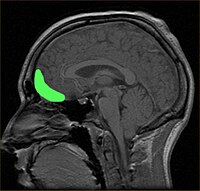
Photo from wikipedia
Behavioral responses to threat are critical to survival. Several cortical and subcortical brain regions respond selectively to threat. However, the relation of these neural responses and their underlying representations to… Click to show full abstract
Behavioral responses to threat are critical to survival. Several cortical and subcortical brain regions respond selectively to threat. However, the relation of these neural responses and their underlying representations to behavior is unclear. We examined the contribution of lower-order subcortical representations to behavioral responses to threat in adult humans. In Experiments 1 and 2, participants viewed pairs of images presented to the same eye or to different eyes. We observed a monocular advantage, which indicates subcortical facilitation, for ancestral threats (snakes, spiders), but not for modern threats, positive images, or neutral images. In Experiment 3, we presented pairs of snakes or neutral images into the temporal or nasal hemifield. For snakes only, we observed a temporal hemifield advantage, which indicates facilitation by the retino-tectal subcortical pathway. These results advance the current understanding of processing of threat by adult humans by revealing the characteristics of behaviors driven by a lower-order neural mechanism that is specialized for the processing of ancestral threats. The results also contribute to ongoing debates concerning the biological generality of neural mechanisms for processing of complex, emotionally-relevant stimuli by providing evidence for conservation of lower-order neural mechanisms for processing of ancestral threats across both ontogeny and phylogeny.
Journal Title: Scientific Reports
Year Published: 2017
Link to full text (if available)
Share on Social Media: Sign Up to like & get
recommendations!